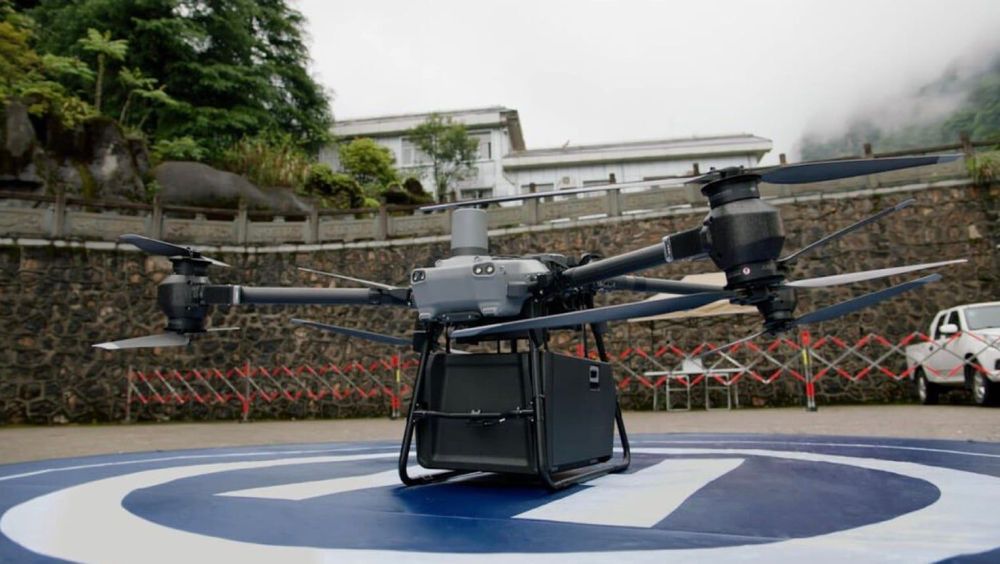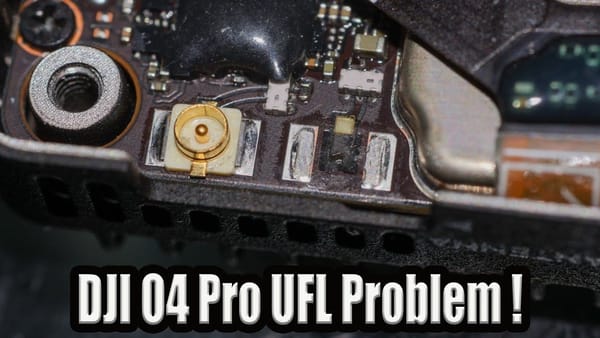What's up, my unmanned tech friends! I've got some exciting news to share with you today in the world of drones. DJI, the biggest name in consumer drones, just announced a brand new delivery drone called the DJI FlyCart 30. This thing looks seriously cool and has some really impressive specs. It could be a total game-changer for drone delivery, which is still a relatively new concept but growing fast.
Let's Break Down the Key Details on DJI's Hot New FlyCart 30
Alright, so DJI is marketing this new aircraft as a heavy-lift utility drone built specifically for delivery uses. It's their first entry into the delivery drone space, which makes sense because delivery is expected to be one of the biggest drone applications in the near future. Consumer demand for fast drone delivery is definitely increasing.
The FlyCart 30 is a beast in terms of lifting capability. It can carry a maximum load of 30kg (about 66lbs) in its standard cargo box configuration. That's heavy! For comparison, most commercial delivery drones currently in operation max out at around 5kg (11lbs) of payload capacity.
So right off the bat, the FlyCart 30 opens up all kinds of new package size and weight possibilities compared to current delivery drones. We're talking larger parcels, multiple deliveries bundled together, and heavier items like food and drink orders. Very cool capabilities.
The FlyCart 30 Has Two Different Delivery Modes
One of the most unique things about DJI's FlyCart 30 is that it has two different modes for making deliveries:
Cargo Box Mode
In cargo box mode, there's a big 70L detachable cargo container that the drone carries underneath its body. It can be loaded up with packages, latched securely to the drone, and then flown autonomously along a delivery route.
When it reaches the destination, the drone lands, unlatches the cargo box, and takes back off. The recipient is left with their package on the ground, no signature required. Easy peasy!
The cargo box has some cool built-in features too. It does automatic weight and balance measurements when loaded to optimize stability, and has a quick-release latching system so loading/unloading only takes a few minutes. Sweet!
Winch Mode
The other delivery mode is called winch mode. This allows the FlyCart 30 to lower packages from the air on a retractable cable/winch system. So the drone flies to the delivery spot, unreels the cable down to ground level or a rooftop or whatever, and gently lowers the package. Recipient grabs package, drone retracts cable, and flies away.
This winch mode is perfect for situations where the drone can't land close to the delivery location, like in dense urban areas or up on rooftops. DJI says the winch can lower up to 40kg (88lbs) and has an automatic anti-sway system to keep packages stable. Amazing!

Here are Some More Technical Specs on the FlyCart 30:
| Specification | Value |
|---|---|
| Empty weight | 42.5kg (without batteries) 65kg (with dual batteries) |
| Maximum take-off weight | 95 kg (standard cargo box, near sea level) |
| Dimensions (arms extended, propellers extended) | Length 2800 mm, width 3085 mm, height 947 mm |
| Maximum flight distance (no load) | Dual battery: 28km Single battery: 12km |
| Maximum flight distance (full load) | Double battery (30kg load): 16km Single battery (40kg load): 8km |
| Maximum flight time (full load) | Double battery (load 30kg): 18 minutes Single battery (load 40kg): 9 minutes |
| Operating temperature | -20°C to 45°C |
| IP Rating | IP55 |
| Maximum horizontal flight speed | 20 m/s (with a load of 30kg) |
| Maximum flight altitude | 6000 metres (without load) |
| Maximum wind speed | 12 m/s (with a load of 30kg) |
| Maximum Flight Altitude | 6,000 metres (without load); 3,000 metres is maximum safe flight altitude for the drone with a full load |
| Image Transmission | 20 km (FCC) 8 km (CE/SRRC/MIC) |
| 4G | 4G Convergence Function: Yes, DJI enhanced image transmission module. 4G Dongle Models: DJI Enhanced Video Transmission Module |
DJI packed this thing with redundancy and safety features to make it reliable enough for professional delivery work. It's also got the long range and flight speed needed to make drone delivery efficient on a large scale.
The weatherproofing and parachute are nice peace-of-mind touches too. Gotta protect those packages!
DJI FlyCart 30: How Much Does This Bad Boy Cost?
Now for the question you've all been wondering - how much is this high-tech drone delivery machine gonna set you back?
Well, DJI has slapped an initial price tag of around $17,000 on the FlyCart 30 for the Chinese market. For that princely sum, you get the FlyCart 30 itself, a fancy DJI controller, two smart batteries, and the required chargers.
DJI also launched a new cloud-based management platform called DJI Transport that helps organize and track entire fleets of FlyCart 30s. Handy for big delivery operations.
While only available in China for now, DJI hinted at a wider global launch in the future as regulations allow. This thing is too cool not to end up in the hands of drone jockeys worldwide eventually!
Given DJI's reputation for high-quality drones and the impressive capabilities of the FlyCart 30, I'd expect it to generate major buzz as soon as it hits international markets. This dropoff drone is gonna sell like hotcakes!
For all us drone nerds outside China, let's keep our fingers crossed for a speedy rollout. I know I'm already saving my pennies in eager anticipation!

What Are the Benefits of Delivery Drones?
Alright, so now that we know what the FlyCart 30 is all about, let's talk about why delivery drones in general are so game-changing. What makes them such a big upgrade over traditional delivery methods?
Faster Deliveries
First up is the potential for much faster deliveries. We're talking nearly instant shipping in some cases. Drones fly direct as the crow flies, don't have to deal with traffic or stoplights, and don't get tired like human drivers. Big time savings!
Lower Costs
Once the initial drone investment has been made, the per-delivery operating costs can be much lower compared to trucks and vans. No gas expenses and lower labor costs. Drones are automated and can run basically 24/7 too.
Reduced Traffic and Emissions
With drones handling more deliveries, fewer traditional diesel vehicles need to be out on the roads congesting traffic and polluting the air. It's a greener transport method overall.
New Delivery Capabilities
Drones open up delivery possibilities that were never feasible before. Like lowering packages straight down onto high-rise balconies or rooftops in congested cities. Or delivering urgently needed supplies into disaster zones too dangerous for pilots or drivers to enter.
More Efficient Logistics
Drone delivery allows for very streamlined logistics since every flight is point-to-point. No inefficient backtracking or roundabout routing required like with road vehicles that have to follow streets. Warehouse to doorstep is usually a nice straight line.

Delivery Drones Have Ton of Potential Applications
It's not just Amazon looking to get in on the drone delivery game. There are tons of industries and use cases that could benefit from this technology.
E-Commerce and Online Shopping
Faster and cheaper shipment of online purchases is one of the most obvious drone delivery applications. Getting that impulse buy to your door in 30 minutes or less? Yes please!
Food Delivery
Pizza and food delivery drones are already being tested in some areas. Eventually you may get your lunch dropped right in your backyard by a drone instead of a person.
Medical Deliveries
Delivery drones have huge potential to transport urgent medical items like medications, blood samples for labs, medical equipment between hospitals, or even donor organs for transplant!
Disaster Relief
When disaster strikes and road access is limited, drones offer an invaluable capability to airlift crucial supplies like food, water, and medicine into affected zones. They can save lives in dire situations.
Remote Communities
For small towns or villages without good road access, drones provide a way to ship in goods, mail, and necessities that would otherwise involve difficult logistics. Bridging geographic divides.
As you can see, we've only begun tapping into all that drones are capable of from a delivery perspective. Their potential to revolutionize supply chains and logistics is enormous. The applications are practically endless!

What's the Drone Delivery Outlook for the UK?
DJI said they plan to initially launch the FlyCart 30 only in China for now. That makes sense given China's huge e-commerce market and more mature drone regulations.
But it seems clear that DJI plans to expand the drone to other countries in the near future. And I know there's tons of interest in drone delivery across Europe and in the UK particularly.
The UK government actually has a drone "superhighway" project in development that would establish an entire air corridor between multiple cities for drone flights. Very cool!
There have also been UK trials by companies like Royal Mail for deliveries in remote areas. And hospital trusts testing drone transport of medical items.
So the appetite is clearly there. Introducing the FlyCart 30 to the UK seems like an obvious next step to meet that demand and continue pushing the drone delivery envelope.
I'll be keeping my eyes peeled for any indication from DJI that they plan to bring their game-changing new delivery drone to British shores! Certainly an exciting possibility on the horizon.
Wrap Up
Alright friends, that wraps up my breakdown of DJI's brand new FlyCart 30 delivery drone and why it has so much potential. This heavy-lifting aircraft really moves the needle for drone delivery capabilities.
I'll be eager to see it enter real-world service delivering packages, food orders, medical supplies, and more. Such a cool piece of technology that provides a glimpse into the future of automated supply chain logistics.
Let me know what you think of the FlyCart 30! Are delivery drones the next big thing? Or just hype? Hit me up on Twitter and share your thoughts. I love chatting all things drones.







